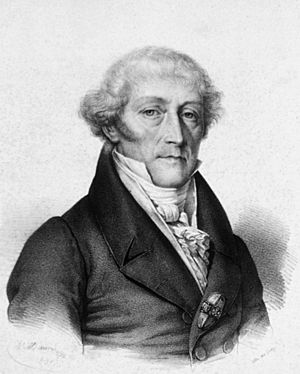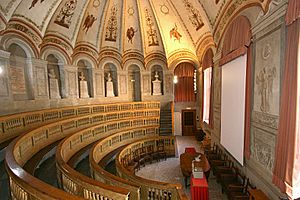Antonio Scarpa facts for kids
Quick facts for kids
Antonio Scarpa
|
|
|---|---|
 |
|
| Born | 9 May 1752 Motta di Livenza
|
| Died | 31 October 1832 (aged 80) Bosnasco
|
| Nationality | Italian |
| Alma mater | University of Padua |
| Scientific career | |
| Fields | anatomist |
| Institutions | University of Modena |
| Academic advisors | Giovanni Battista Morgagni |
| Notable students | Ignaz Döllinger |
Antonio Scarpa (born May 9, 1752 – died October 31, 1832) was a famous Italian anatomist and professor. An anatomist is a scientist who studies the structure of living things, like the human body. Scarpa made many important discoveries about how our bodies work.
Contents
Life and Education
Antonio Scarpa was born into a family that didn't have much money in a small town called Motta di Livenza, Italy. His uncle, who was a priest, taught him until he was 15 years old. At that age, he passed the entrance exam for the University of Padua.
He studied under two important teachers, Giovanni Battista Morgagni and Marc Antonio Caldani. He earned his medical degree on May 19, 1770. Just two years later, in 1772, he became a professor at the University of Modena.
Travels and New Roles
After some time, Scarpa decided to travel and learn more. He visited countries like Holland, France, and England. When he came back to Italy, he became a professor of anatomy at the University of Pavia in 1783. This happened because Emperor Joseph II strongly recommended him.
His lessons were so popular with students that Emperor Joseph II asked a famous architect, Leopoldo Pollack, to build a new anatomy theater. This theater, now called Aula Scarpa, is still at the Old Campus of the University of Pavia.
Scarpa stayed in this job until 1804. He then stepped down to let one of his students, Santo Fattori, take over the position. In May 1791, he was chosen as a Fellow of the Royal Society in England. This was because of his smart observations on nerves, and the structure of the hearing and smell organs.
Napoleon's Visit and Later Life
In 1805, when Napoleon became the King of Italy, he visited the University of Pavia. He asked about Dr. Scarpa and was told that Scarpa had been dismissed because of his political views. Napoleon then made sure Dr. Scarpa was given his professor job back. In 1821, he was also chosen as a foreign member of the Royal Swedish Academy of Sciences.
Antonio Scarpa became quite wealthy during his life. He collected valuable paintings and lived a comfortable lifestyle. He died in Pavia on October 31, 1832, at the age of 80.
Important Works and Discoveries
Dr. Scarpa wrote many important medical books that were highly respected by other scientists.
- De structura fenestrae rotundae auris et de tympano secundario, anatomicae observationes (1772): This was his first published work. It focused on the structure of the inner ear, which helps us hear.
- Anatomy of Hearing and Smell (1789): He published Anatomicæ disquisitiones de auditu et olfactu, a detailed study of the organs we use for hearing and smelling. It quickly became a classic book on the topic.
- Tabulae neurologicae (1794): This book is considered his best work. It was the first to accurately show the nerves of the heart and how they connect. In this work, he also discovered that the inner ear is filled with fluid. This fluid was later named Scarpa's fluid, and is now called endolymph.
- Bone Structure (1799): His book Commentarius de Penitiori Ossium Structura described the tiny cell structure of bones. It also included notes on how bones grow and what diseases can affect them.
- Eye Diseases (1801): In Saggio di osservazioni e d'esperienze sulle principali malattie degli occhi, Scarpa described and drew pictures of major eye diseases. This was the first ophthalmology (study of eyes) textbook published in Italian. It was later translated into many languages, earning him the title "father of Italian ophthalmology."
- Aneurysms (1804): Riflessioni ed Osservazione anatomico-chirugiche sull' Aneurisma is a very important book about Aneurysms, which are dangerous bulges in blood vessels.
- Hernias (1809): His book Sull'ernie memorie anatomico-chirurgiche was a detailed study of hernias. A hernia happens when an organ pushes through a weak spot in the muscle or tissue that holds it in place. Later, he wrote Traité pratique des hernie, which became a leading book on the subject. Some parts of the body, like Scarpa's fascia and Scarpa's triangle, were named after his work on hernias.
Things Named After Scarpa
Many parts of the human body or medical terms are named after Antonio Scarpa because of his important discoveries:
- Scarpa's fascia
- Scarpa's fluid
- Scarpa's foramina
- Scarpa's ganglion
- Scarpa's hiatus
- Scarpa's membrane
- Scarpa's sheath
- Scarpa's shoe
- Scarpa's staphyloma
- Scarpa's triangle
See also
 In Spanish: Antonio Scarpa para niños
In Spanish: Antonio Scarpa para niños


